With many UK workers likely to be planning a job switch this year, Ciphr investigated which towns and cities offer the most employment opportunities for job hunters and those considering a change of career.
↓↓↓ Scroll down to find out which towns and cities rank the highest for job opportunities, salary growth, affordability, and more ↓↓↓
Best UK towns and cities for job opportunities
To discover which locations in the UK have the best job opportunities, Ciphr ranked 100 of the most populous towns and cities in the country based on factors like average salary, wage growth, employment rate growth, unemployment rate, job listings, and the number of businesses.
House prices and rental costs were also included in the analysis to reflect the city’s affordability and cost of living, as were life satisfaction and happiness scores (from the Office for National Statistics) to show the population’s general level of wellbeing.
Points were allocated based on where each town or city ranked between the highest and lowest values for each factor/metric (for example, the place with the highest salary scored 100, while the location with the lowest salary scored 1). The results were then weighted, and the town or city with the highest overall score out of 100 was ranked first on the index.
Main findings for 2024:
-
Winchester, Warrington, St Albans, Chelmsford, and Sevenoaks are the top five towns and cities for job opportunities, with good average salaries, high business density, and lower-than-average unemployment rates.
-
Newcastle-under-Lyme is the best UK town for employment rate growth, up 23.9% in 2023. Its employment rate is one of the highest in the UK at 89.6%
-
Sevenoaks has the highest wage growth of any town in the study, with the latest figures showing an above-inflation 18.2% increase in full-time annual earnings to £41,239
-
St Albans has the highest average salary for full-time employees at £47,641 (36% above the national average of £34,963)
-
Winchester has the highest business density of any UK city at 179.1, which means that there are over 179 businesses (with over 10 employees) for every 10,000 local workers. Stratford-upon-Avon has the next highest business density at 107.3 (the UK average is 70.2)
-
Solihull saw the biggest (11.9%) increase in number of businesses (with over 10 employees) between 2022 and 2023. Canterbury and Telford also saw their business numbers rise by 9%
-
Sevenoaks, St Albans, Maidstone, Lancaster, and Havant are among the happiest places to live and work, with residents reporting higher levels of life satisfaction and personal happiness than any other towns and cities in the study
-
Blackburn, Stockton-on-Tees, Preston, Wigan, and Hull are the UK towns and cities with the most affordable housing (to rent or buy on an average full-time salary)
Best UK towns and cities for salary growth
-

Southend-on-Sea
#2 for salary growth
-

Plymouth
#3 for salary growth
-

Preston
#4 for salary growth
Sevenoaks in Kent tops the list for salary growth. According to the latest figures from the ONS, full-time workers living in Sevenoaks saw a significant 18.2% increase in their average earnings in 2023.
.jpg?width=726&height=481&name=iStock-948454524-Sevenoaks%20(2).jpg)
Which UK towns and cities saw the biggest pay rises?
The towns and cities with the highest growth in earnings for full-time employees in the last year are:
- Sevenoaks (18.2% increase to £41,239)
- Southend-on-Sea (17.3% increase to £39,260)
- Plymouth (16% increase to £31,615)
- Blackburn (14.8% increase to £31,527)
- Preston (14.8% increase to £33,188)
- Winchester (14.8% increase to £40,600)
Other places that saw inflation-busting pay rises (of 10% or more) include Ipswich, Warwick, Rochdale, Bolton, and Manchester.
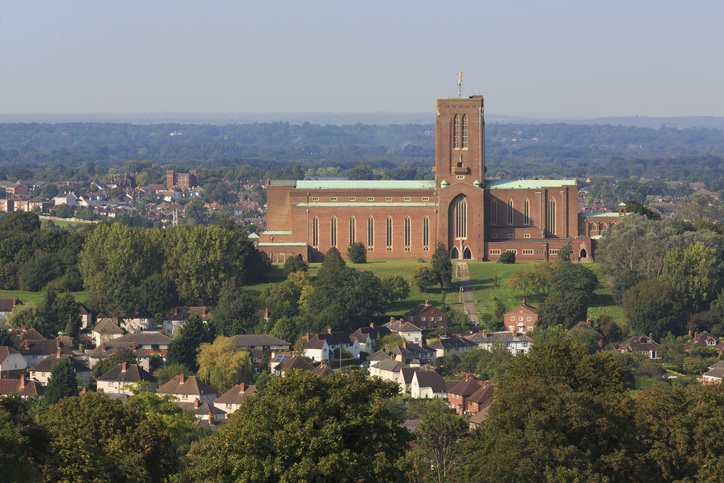
The towns and cities with the lowest growth in earnings for full-time employees in the last year are:
- Guildford (-6.1% decrease to £40,142)
- Cheltenham (-5.5% decrease to £35,973)
- Maidstone (-4.1% decrease to £33,369)
- York (-2.1% decrease to £32,251)
- St. Helens (-1.6% decrease to £32,386)
Guildford's full-time average wage may have fallen since 2022 but at £40,142 per year, it is still 15% higher than the UK's average (of £34,963).
Towns and cities with the best-paying full-time jobs
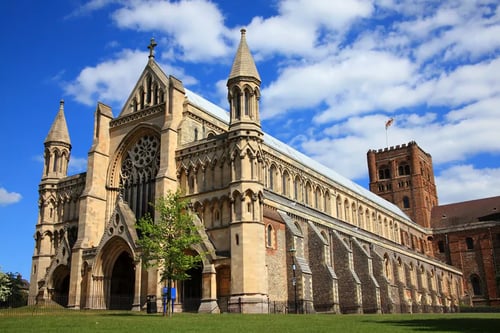
St Albans is among one of the least affordable cities to live in the UK but it does have the highest average salary for full-time workers of £47,641 (36% above the national average of £34,963).
The next highest-paying city is London, with an average salary of £41,853, followed by Warwick and Sevenoaks.
- St Albans: £47,641 (36% above UK average)
- London: £41,853 (20% above UK average)
- Warwick: £41,242 (18% above UK average)
- Sevenoaks: £41,239 (18% above UK average)
- Cambridge: £40,914 (17% above UK average)
Best UK towns and cities for employment opportunities
-

Exeter
#5 for employment opportunities
-
.jpg?width=1200&length=1200&name=iStock-481885488-Bath%20(2).jpg)
Bath
#7 for employment opportunities
-

Reading
#10 for employment opportunities
Generally, towns and cities that have a high number of businesses per capita are more likely to be able to provide more employment opportunities, than towns and cities with a smaller number of employers. But, that's not the only criteria that Ciphr measured.
The towns and cities that rank highest for employment opportunities in Ciphr's study also have higher-than-average employment rates (the percentage of the location's working age population that is employed), good employment rate growth, and the lowest unemployment rates – factors that are associated with favourable economic conditions and a buoyant labour market. They also have a higher number of job postings (on Indeed, LinkedIn and Glassdoor combined) per 10,000 working adults.
The best UK city for employment opportunities is Winchester, scoring an impressive 85 out of 100 points.
In Winchester, there are around 179.1 businesses (with 10+ employees) per 10,000 working age population. That's significantly higher than the UK average of 70.2 per 10,000. The city's employment rate is also above average at 81.1% (up 8.6% since 2022) and the unemployment rate is below average at 2.7%.
Chelmsford, Warrington, Guildford, and Exeter also scored well (81 or higher) for employment opportunities.

The best cities in UK for employment opportunities are:
- Winchester (85 out of 100)
- Chelmsford (83)
- Warrington (82)
- Guildford (81)
- Exeter (81)
- Gloucester (79)
- Cheltenham (78)
- Bath (77)
- Chester (75)
- York (72)
- St Albans (72)
- Edinburgh (72)
- Reading (72)
Bradford and Birmingham were just outside the top 20, ranking at #21 and #22 respectively for employment opportunities. Many of the UK's other biggest cities appear lower down the list, including Glasgow, Cardiff, Leeds, London, and Manchester at #40, #43, #48, #51, and #58 respectively.
Where is the employment rate highest in the UK?
In the year to December 2023, Newcastle-under-Lyme in Staffordshire recorded one of the highest employment rates in the UK at 89.6%. This was a 23.9% increase on the previous year.
Reading, Ipswich, Stratford-upon-Avon, and St Albans also have employment rates of 85% or more.
Where is unemployment lowest in the UK?
Northern Ireland (which includes the figures for Belfast) has one of the lowest reported unemployment rates in the UK, at 2.2%. Of the towns and cities in Ciphr's study, Cheltenham, Guildford, York, and Bath have the next lowest unemployment rate, of 2.5%. In the year to December 2023, the UK's unemployment rate was 3.7%.
Which towns and cities have the most job vacancies listed?
Based on figures from three different job sites (Indeed, Glassdoor, and LinkedIn) the city with the highest number of job vacancies listed per person is Cambridge. As at July 2024, 1,151 jobs are being advertised in Cambridge per 10,000 working age adults.
Job hunters in Manchester, Bristol, Oxford and Exeter are also well-served, with an average of 777 listings per 10,000 local workers (the UK average is around 243).
Which UK towns and cities have seen the biggest increase in businesses?
Solihull, in the West Midlands, saw the biggest, double-digit (11.9%) growth in the number of businesses (with 10 employees or more) in 2023.
Other towns and cities that have increased their business population since 2022 include Canterbury (by 9%), Telford (8.6%), and Stafford (7.7%)
Which towns and cities have the most businesses?
After London (51,455), Birmingham and Leeds have the most small, medium and large businesses (with 4,075 and 3,745 respectively).
When adjusted for working age population, it's Winchester that has the highest density of employers at 179.1. This means that there are over 179 businesses, with over 10 employees, for every 10,000 working age residents (the UK average is 70.2 per 10,000).
Towns and cities with the highest number of businesses per person
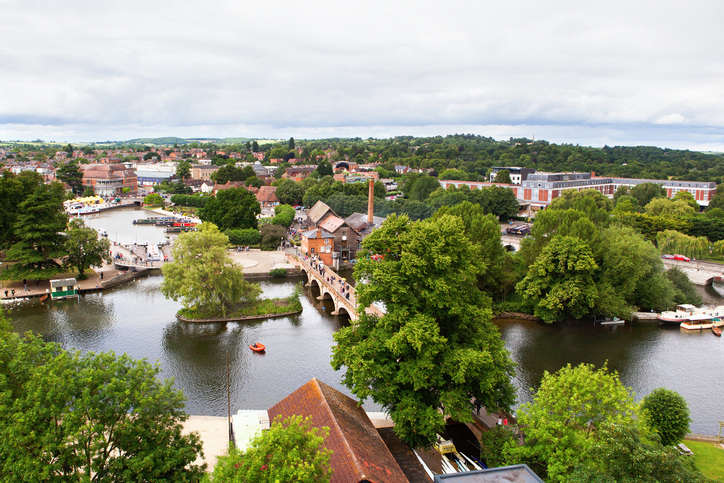
Business density is highest in the following UK towns and cities:
- Winchester (179.1 businesses with 10+ employees per 10,000 working age adults)
- Stratford-upon-Avon (107.3)
- Chichester (98.5)
- Sevenoaks (90.6)
- Warwick (89.0)
- Guildford (87.2)
- Horsham (85.6)
- London (84.3)
- St Albans (84.0)
- Belfast (82.1)
Slough has the highest density of larger employers (with over 100 employees), with 10.6 per 10,000 working-age population. Warwick, Milton Keynes, Aberdeen, Cheltenham, Solihull, Reading, Bracknell, and Norwich all have over 9 per 10,000 (the UK average is 6.1 per 10,000).
Best UK towns and cities for housing affordability
-

Blackburn
#1 for housing affordability
-

Stockton-on-Tees
#1 for housing affordability
-

Hull
#1 for rental affordability
The majority of UK towns and cities with the most affordable housing to rent or buy (comparative to average salaries) are located in the north of England, with Blackburn and Stockton-on-Tees topping the list for 2024 (with 97 out of 100 points each).
The average rental property costs around 21% of the average salary in Blackburn, which is £31,527. While in Stockton-on-Tees the average property costs £146,465 – 4.5x the average salary (of £32,790).
Other towns and cities that are among the most affordable for buying or renting property in the UK are Preston, Wigan, Hull, Doncaster, Rotherham, and Middlesbrough.
At the other end of the scale, housing is the least affordable (when average salaries are taken into account) in London, Sevenoaks, Guildford, Oxford, Brighton and Hove, Cambridge, and Slough.
How much is the average property to buy in the UK?
The average UK property now costs £281,000 (as of April 2024), which is 8x the average UK salary of £34,963.

Revealed: the 10 most affordable towns and cities to rent or buy in the UK:
- Stockton-on-Tees
- Blackburn (with Darwen)
- Preston
- Wigan
- Hull
- Doncaster
- Rotherham
- Middlesbrough
- St. Helens
- Barnsley
Rental affordability
← A chart highlighting the difference in average full-time pay across the UK vs the local area's average salary-to-rent ratios.
Click on (or hover over) any town or city to explore where in the UK it is the most and least affordable to rent a property.
The UK towns and cities that have the lowest rent-to-salary ratio are:
- Hull (20% of the average salary is spent on rent)
- Doncaster (20%)
- Barnsley (20%)
- Preston (21%)
- Blackburn (21%)
- Rotherham (21%)
- Stockton-on-Tees (21%)
- Stoke-on-Trent (21%)
- Middlesbrough (21%)
As of April 2024, the average monthly rent in the UK was £1,226 (including London, according to Zoopla). This means that full-time workers in the UK, earning an average of £34,963 per year, spend around 42% of their monthly earnings on rent.

UK towns and cities that have the highest rent-to-salary ratio:
- London (47% of the average salary is spent on rent)
- Brighton and Hove (45%)
- Oxford (45%)
- Bristol (44%)
- Edinburgh (42%)
'Buying power' – property affordability
← A chart highlighting the difference in average full-time wages across the UK vs the local area's average property cost.
Click on (or hover over) any town or city to explore where in the UK it is the most and least affordable to buy a property.
Towns and cities with the lowest average property prices* in the UK (comparative to average wages):
- Stockton-on-Tees: £146,465 (4.5x the average salary)
- Belfast: £164,101 (5x)
- Blackburn: £159,432 (5.1x)
- Aberdeen: £182,000 (5.2x)
- Wigan: £174,199 (5.3x)
- Preston: £178,247 (5.4x)
- Middlesbrough: £157,105 (5.4x)
- St. Helens: £174,354 (5.4x)
- Gateshead: £172,177 (5.4x)
- Birkenhead: £187,003 (5.4x)
The average sold price for property in the UK in the last year was £281,000 – that's 8x a typical full-time worker's salary.
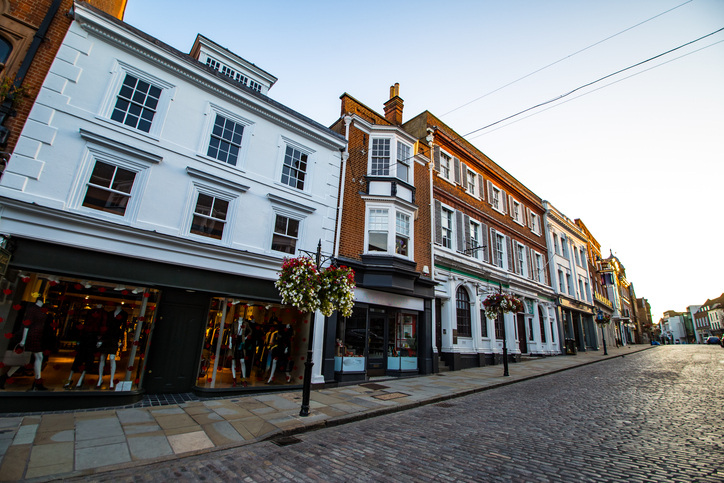
UK towns and cities with the highest average property prices* (comparative to the average salary):
- Guildford: £840,608 (20.9x average salary)
- Sevenoaks: £740,031 (17.9x average salary)
- London: £689,410 (16.5x average salary)
- Winchester: £665,891 (16.4x average salary)
- Bath: £594,503 (15.6x average salary)
*Average sold prices in the last year (as at July 2024, Rightmove)
Best UK cities for life satisfaction and happiness
-

Maidstone
#3 for happiness and life satisfaction
-

Lancaster
#4 for happiness and life satisfaction
-

Oxford
#3 for life satisfaction
According to the results of the ONS’ latest* annual personal wellbeing survey, the residents of Sevenoaks, St Albans and Maidstone enjoy higher levels of life satisfaction and personal happiness than any other towns and cities in the study, with an average score of 15.6 out of 20.
The people of St Albans and Maidstone feel the most satisfied about their lives overall, while those living in Sevenoaks, Chelmsford and Preston are among the happiest.
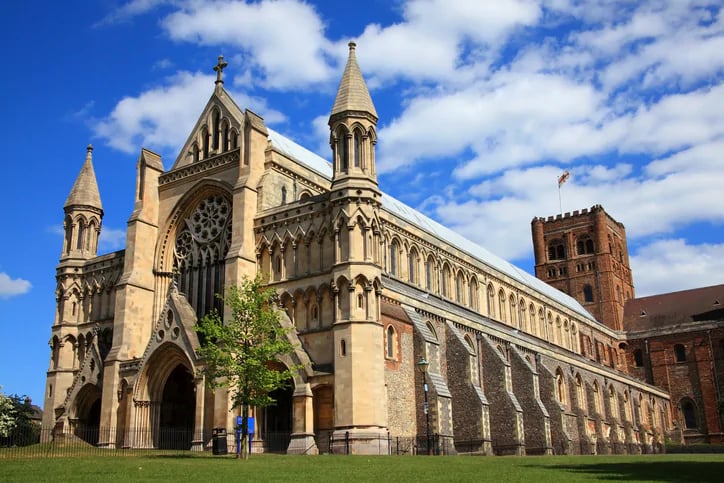
The UK towns and cities where residents reported the highest life satisfaction scores are:
- St Albans: 7.97 out of 10
- Maidstone: 7.92 out of 10
- Oxford: 7.8 out of 10
- Colchester: 7.78 out of 10
- Sevenoaks: 7.73 out of 10
- Winchester: 7.72 out of 10
- Edinburgh: 7.69 out of 10
- Stratford-on-Avon: 7.68 out of 10
- Lancaster: 7.63 out of 10
- Ipswich: 7.62 out of 10
.jpg?width=726&height=481&name=iStock-948454524-Sevenoaks%20(2).jpg)
'The happiest towns and cities to live in the UK' – top 10 places with the highest happiness scores:
- Sevenoaks: 7.89 out of 10
- Chelmsford: 7.79 out of 10
- Preston: 7.79 out of 10
- Lancaster: 7.78 out of 10
- Havant: 7.77 out of 10
- Cheltenham: 7.73 out of 10
- Bridgend: 7.72 out of 10
- Plymouth: 7.71 out of 10
- Bracknell: 7.67 out of 10
- Luton: 7.64 out of 10
*April 2022 to March 2023.
Best UK cities for job opportunities – #16-33
Full results
-
 Blackpool
Blackpool -
 Cardiff
Cardiff -
 Birmingham
Birmingham
UK's best towns and cities for job opportunities
Top 50 towns and cities for job opportunities: weighted results
-
 Bristol
Bristol -
 Edinburgh
Edinburgh -
 Belfast
Belfast
The chart below illustrates how each city was scored (out of 100) for various criteria. Each location was ranked against each other across 10 different metrics, including:
- Salary or earnings potential – average salary (triple weighted) and salary growth
- Employment opportunities – business density, growth in the number of businesses, employment rate, employment rate growth, unemployment rate (double weighted), and number of job listings per 10,000 working adults
- Housing affordability – to rent and buy
- Life satisfaction and personal happiness
The higher a town or city appears in the ranking, then the higher the score (with 100 points being the highest and one point the lowest). Weighting was then applied to the results for each of the 10 metrics to determine the location's overall position in the list of best UK towns and cities for job opportunities.
Use the search box to check the results for your town or city ↓↓↓
Methodology and sources
Ciphr compared total population figures from the Office for National Statistics to determine which 100 UK towns and cities were considered in the rankings, with only the most populous locations included in its analysis.
The UK's 100 largest towns and cities (by estimated mid-2022 local authority population) are: London, Birmingham, Leeds, Glasgow, Manchester, Sheffield, Bradford, Edinburgh, Liverpool, Bristol, Huddersfield (Kirklees), Northampton (West Northamptonshire), Bournemouth (BCP), Leicester, Cardiff, Chester (Cheshire West and Chester), Wakefield, Coventry, Belfast, West Bromwich (Sandwell), Wigan, Nottingham, Dudley, Birkenhead (Wirral), Doncaster, Newcastle, Bolton, Stockport, Milton Keynes, Walsall, Salford, Brighton and Hove, Sunderland, Hull, Rotherham, Wolverhampton, Plymouth, Derby, Stoke-on-Trent, Southampton, Barnsley, Oldham, Swansea, Swindon, Rochdale, Luton, Aberdeen, Peterborough, Solihull, Warrington, Portsmouth, York, Stockton-on-Tees, Gateshead, Bath (and North East Somerset), Bury, Colchester, Telford (and Wrekin), Basildon, Basingstoke (and Deane), Bedford, St. Helens, Chelmsford, Wokingham, Southend-on-Sea, Maidstone, Caerphilly, Reading, Oxford, Newport, Slough, Canterbury, Blackburn (with Darwen), Preston, Warwick, Horsham, St Albans, Dundee, Middlesbrough, Cambridge, Bridgend, Guildford, Norwich, Lancaster, Blackpool, Ipswich, Stafford, Stratford-upon-Avon, Ashford, Wrexham, Exeter, Gloucester, Winchester, Bracknell, Chichester, Newcastle-under-Lyme, Havant, Sevenoaks, Crawley, and Cheltenham.
Multiple criteria were researched and analysed to discover which UK towns and cities ranked best overall for job opportunities, including average salary, salary growth, business density (calculated by Ciphr), business population growth, number of job postings per 10,000 working age population (using LinkedIn, Glassdoor and Indeed), employment rate, employment rate growth, unemployment rate, housing affordability, and life satisfaction and personal happiness.
The following statistical weights were applied to the scores for each metric:
- Average salary: triple weight (20%) + Change in average salary in the last 12 months: regular weight (6.7%). Total weight = 26.7%
- Business density + change in number of businesses in the last 12 months + employment rate + change in employment rate in the last 12 months + number of job postings: regular weight (33.5%) + Unemployment rate: double weight (13.3%). Total weight = 46.8%
- Housing affordability (% of salary spent on rent + multiple of average salary required to buy average property): double weight (13.3%). Total weight = 13.3%
- Life satisfaction + happiness score (how satisfied people feel about their life overall and their levels of personal happiness): double weight (13.3%). Total weight = 13.3%
Data sourced from the Office for National Statistics (ONS):
- Mid-2022 estimates of the population for the UK, England, Wales, Scotland and Northern Ireland (released on 26 March 2024) – Table MYE2: Persons by single year of age and sex for local authorities in the UK, mid-2022: http://bit.ly/3WuIUdM
- Earnings and hours worked, place of residence by local authority – ASHE Table 8.7a (released on 1 November 2023): http://bit.ly/3XHxPHm
- UK business: activity, size and location – Table 10 (released on 27 September 2023): http://bit.ly/3XLXCOQ
- Private rental market summary statistics in England – Table 2.7 (released on 20 December 2023): http://bit.ly/3IZC3WM
- Annual personal well-being estimates - April 2022 to March 2023 edition (released on 7 November 2023): http://bit.ly/3GYRQ5B
- LI01 Regional labour market: Local indicators for counties, local and unitary authorities – April 2024 edition (release date: 16 April 2024) and April 2023 edition (release date 18 April 2023): http://bit.ly/3XmCmiG
Other data sources:
- Zoopla UK Rental Market Report (published June 2024). For average rents in Wales, Scotland and Northern Ireland (plus the UK average): http://bit.ly/3wib0yh
- Rightmove – sold house prices (accessed 8 July 2024): http://bit.ly/3kxGNZD
- NISRA – Northern Ireland House Price Index Quarter 1 2024 (published: 22 May 2024): http://bit.ly/3D2wJ10
- GOV.UK / HM Land Registry – UK House Price Index summary: April 2024 (published 19 June 2024): https://bit.ly/3SbBY65
- Indeed, Glassdoor and LinkedIn (accessed 8-9 & 25 July 2024)
Where data was unavailable or unreported for any towns or cities included in this study, then local authority, county, or country data was used instead.
Fair use statement: If you are interested in sharing where your town or city ranked in the UK, or quoting this study in an article, please include a link to this infographic page and credit Ciphr. Thanks.
This infographic was first published in February 2023, with Milton Keynes, Oxford, York, St Albans, and Norwich ranked as the top five cities for job opportunities in the UK. The data and findings were updated in July 2024 for accuracy, and the weighting method was modified. The study was also expanded to include the top 100 biggest towns and cities in the UK.



